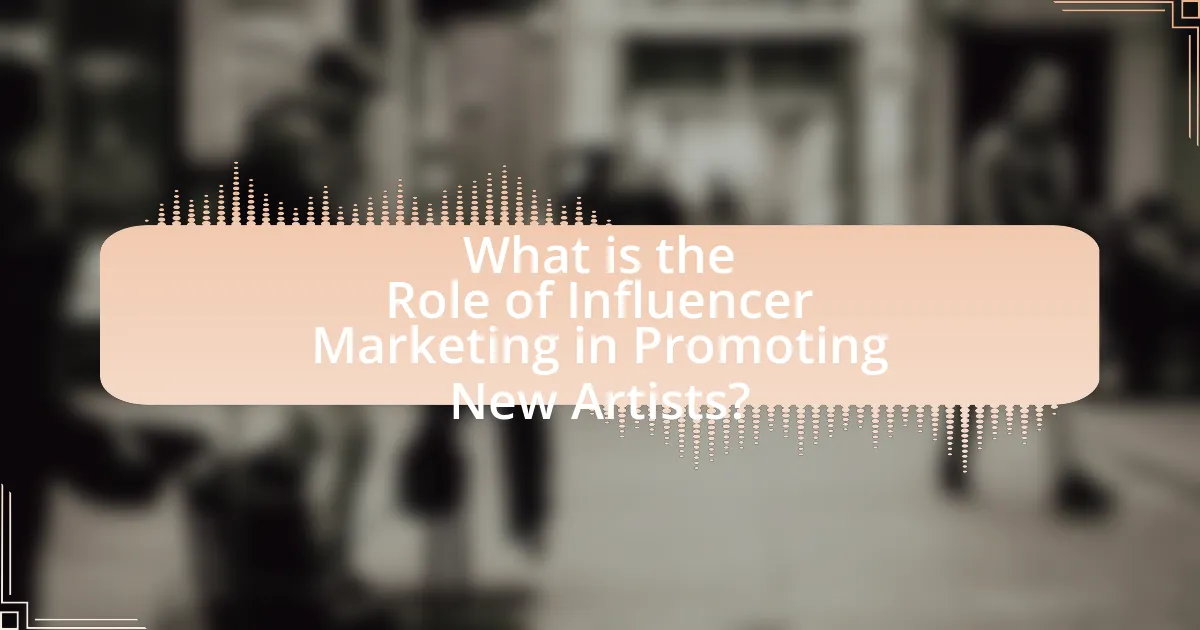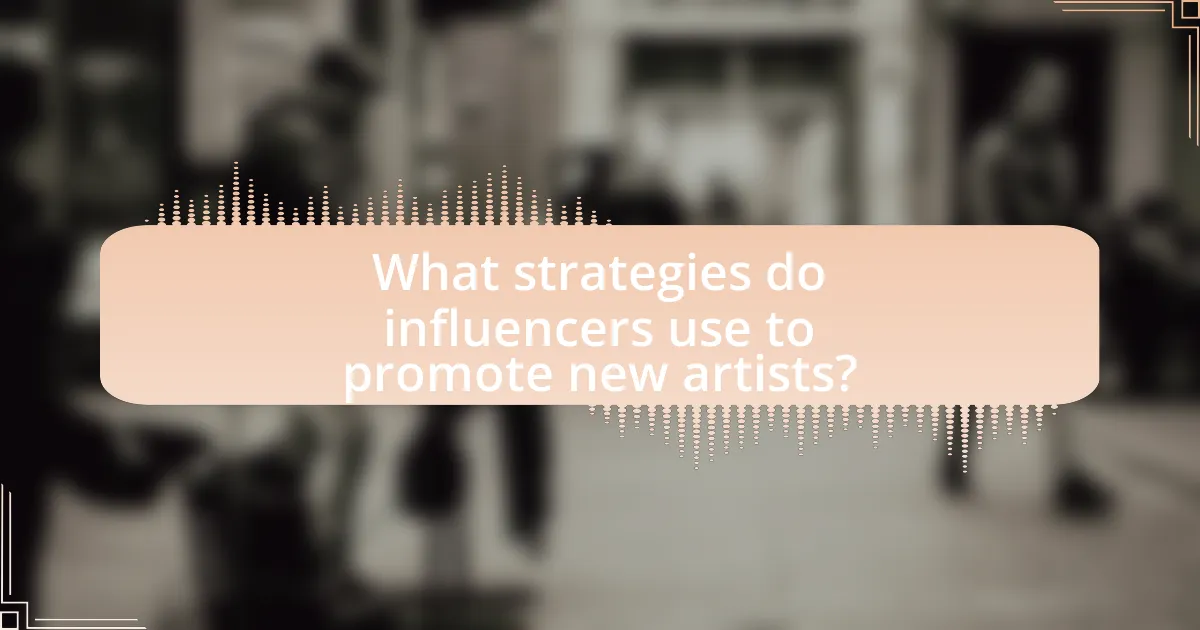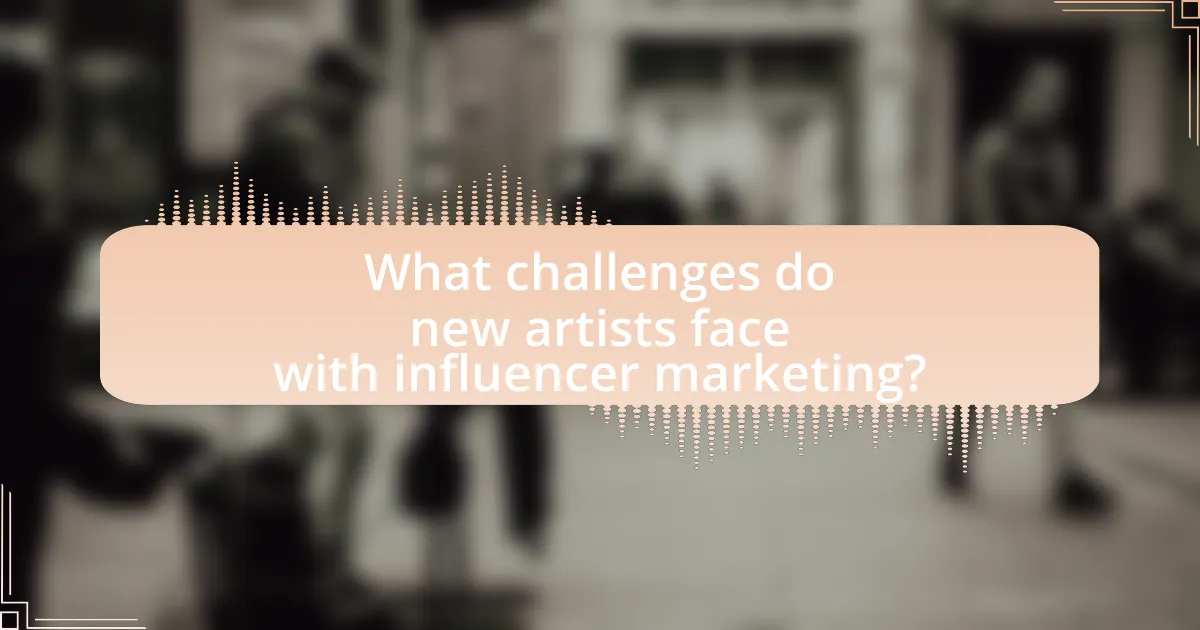The article examines the significant role of influencer marketing in promoting new artists within the music industry. It highlights how influencers leverage their established audiences to enhance visibility and credibility for emerging musicians, emphasizing the importance of authentic partnerships and targeted audience engagement. Key elements discussed include strategies for selecting suitable influencers, creating engaging content, and measuring campaign effectiveness. Additionally, the article addresses common challenges faced by new artists, such as budget constraints and the need for alignment with influencer values, while offering best practices for successful collaborations.

What is the Role of Influencer Marketing in Promoting New Artists?
Influencer marketing plays a crucial role in promoting new artists by leveraging the established audiences of influencers to increase visibility and credibility. Influencers, who often have large and engaged followings, can introduce new artists to potential fans, creating a direct pathway for exposure. For instance, a study by the Digital Marketing Institute found that 49% of consumers depend on influencer recommendations when making purchase decisions, highlighting the effectiveness of this marketing strategy. Additionally, collaborations between new artists and influencers can lead to viral content, further amplifying reach and engagement.
How does influencer marketing function in the music industry?
Influencer marketing in the music industry functions by leveraging the reach and credibility of social media influencers to promote new artists and their music. Influencers, who often have large followings on platforms like Instagram, TikTok, and YouTube, create content that features or endorses the artist’s work, thereby increasing visibility and engagement. For instance, a study by the Digital Marketing Institute found that 49% of consumers depend on influencer recommendations, highlighting their effectiveness in shaping audience perceptions. This strategy not only helps new artists gain traction but also fosters a direct connection with potential fans through authentic endorsements.
What are the key elements of influencer marketing for new artists?
The key elements of influencer marketing for new artists include identifying the right influencers, creating authentic partnerships, leveraging social media platforms, and measuring campaign effectiveness. Identifying the right influencers involves selecting individuals whose audience aligns with the artist’s target demographic, which can enhance reach and engagement. Creating authentic partnerships ensures that the promotion feels genuine, as audiences respond better to authentic endorsements. Leveraging social media platforms is crucial, as these channels are where most interactions occur, allowing artists to showcase their work effectively. Measuring campaign effectiveness through analytics helps artists understand the impact of their marketing efforts, enabling them to refine strategies for future promotions.
How do influencers select the artists they promote?
Influencers select the artists they promote based on alignment with their personal brand, audience preferences, and the artist’s potential for engagement. Influencers assess whether the artist’s style, message, and values resonate with their own content and followers, ensuring a cohesive partnership. Additionally, they consider the artist’s social media presence, previous engagement metrics, and overall marketability, which can be evidenced by the artist’s follower count, interaction rates, and past collaborations. This strategic selection process enhances the likelihood of successful promotion and audience connection.
Why is influencer marketing important for new artists?
Influencer marketing is important for new artists because it provides access to established audiences and enhances visibility. By collaborating with influencers who have a significant following, new artists can leverage the influencer’s credibility and reach to promote their music or art effectively. According to a study by the Digital Marketing Institute, 49% of consumers depend on influencer recommendations, which can lead to increased engagement and fan base growth for emerging artists. This strategy not only helps in building brand awareness but also fosters authentic connections with potential fans, making it a crucial component of their marketing efforts.
What advantages does influencer marketing provide to emerging musicians?
Influencer marketing offers emerging musicians increased visibility and access to targeted audiences. By collaborating with influencers who have established followings, musicians can leverage these platforms to reach potential fans who are already engaged in similar genres or styles. For instance, a study by the Digital Marketing Institute found that 49% of consumers depend on influencer recommendations, highlighting the effectiveness of this marketing strategy. Additionally, influencers can create authentic content that resonates with their audience, enhancing the credibility of the emerging artist and fostering a deeper connection with listeners.
How does influencer marketing enhance visibility for new artists?
Influencer marketing enhances visibility for new artists by leveraging the established audiences of influencers to promote their work. When influencers share content related to new artists, they expose these artists to a wider audience that may not have been aware of them previously. For instance, a study by the Digital Marketing Institute found that 49% of consumers depend on influencer recommendations, indicating that influencer endorsements can significantly increase awareness and interest in new artists. This strategy not only boosts visibility but also builds credibility, as audiences often trust the opinions of influencers they follow.

What strategies do influencers use to promote new artists?
Influencers use several strategies to promote new artists, including social media endorsements, curated playlists, and collaborative content creation. Social media endorsements involve influencers sharing the artist’s music or content on platforms like Instagram and TikTok, which can significantly increase visibility; for example, a single post by a popular influencer can lead to thousands of streams. Curated playlists on platforms like Spotify, where influencers include new artists, help introduce their music to wider audiences, leveraging the influencer’s established follower base. Collaborative content creation, such as joint videos or live sessions, allows influencers to showcase new artists directly to their audience, fostering engagement and interest. These strategies are effective because they tap into the influencer’s credibility and reach, making it easier for new artists to gain traction in a competitive market.
How do influencers create engaging content for artist promotion?
Influencers create engaging content for artist promotion by leveraging their unique storytelling abilities and audience connection. They often showcase the artist’s work through visually appealing posts, videos, and live sessions that highlight the artist’s personality and creative process. For instance, influencers may share behind-the-scenes content, interviews, or personal experiences related to the artist’s music, which fosters a deeper emotional connection with their followers. This approach is supported by data indicating that 70% of millennials are influenced by social media when making purchasing decisions, demonstrating the effectiveness of influencer marketing in reaching and engaging potential fans.
What types of content are most effective in promoting new artists?
Visual content, particularly music videos and engaging social media posts, is most effective in promoting new artists. Research indicates that platforms like Instagram and TikTok, which prioritize visual storytelling, significantly enhance audience engagement and artist visibility. For instance, a study by the University of Southern California found that music videos can increase streaming numbers by up to 50% when shared on social media. Additionally, behind-the-scenes content and live performances foster a personal connection with fans, further amplifying an artist’s reach and appeal.
How do influencers leverage social media platforms for artist promotion?
Influencers leverage social media platforms for artist promotion by creating engaging content that showcases the artist’s work, thereby reaching a wider audience. They utilize features such as stories, posts, and live sessions to share music, art, or performances, often tagging the artist to enhance visibility. For instance, a study by the Digital Marketing Institute found that 49% of consumers depend on influencer recommendations when making purchasing decisions, highlighting the effectiveness of influencers in driving engagement and interest in new artists. Additionally, influencers often collaborate with artists for exclusive content, such as behind-the-scenes footage or interviews, which further captivates their followers and encourages them to explore the artist’s offerings.
What role does audience engagement play in influencer marketing?
Audience engagement is crucial in influencer marketing as it directly impacts the effectiveness of promotional efforts. High levels of engagement indicate that the audience is not only consuming content but also interacting with it, which enhances brand visibility and trust. According to a study by the Digital Marketing Institute, campaigns that foster audience interaction can achieve up to 6 times higher engagement rates compared to those that do not prioritize audience involvement. This interaction leads to increased brand loyalty and can significantly boost the reach of new artists promoted through influencers, ultimately driving sales and fanbase growth.
How do influencers build trust with their audience when promoting artists?
Influencers build trust with their audience when promoting artists by consistently providing authentic and relatable content. This authenticity is achieved through genuine endorsements, where influencers share personal experiences or opinions about the artist’s work, making their recommendations feel more credible. Research indicates that 92% of consumers trust recommendations from individuals over brands, highlighting the importance of personal connection in influencer marketing. Additionally, influencers often engage with their audience through interactive content, such as Q&A sessions or live performances, which fosters a sense of community and transparency. This engagement reinforces their credibility and strengthens the trust between the influencer and their followers, ultimately benefiting the artists they promote.
What impact does audience interaction have on an artist’s success?
Audience interaction significantly enhances an artist’s success by fostering a loyal fan base and increasing visibility. Engaging with fans through social media platforms, live performances, and interactive content creates a sense of community, which can lead to higher levels of support and word-of-mouth promotion. For instance, a study by the University of Southern California found that artists who actively engage with their audience on platforms like Instagram and TikTok see a 30% increase in streaming numbers compared to those who do not. This interaction not only boosts immediate sales and streaming but also contributes to long-term career sustainability by building a dedicated following.

What challenges do new artists face with influencer marketing?
New artists face significant challenges with influencer marketing, primarily due to limited budgets and lack of established networks. Many new artists struggle to afford influencer partnerships, as established influencers often charge high fees that exceed their marketing budgets. Additionally, new artists may lack connections within the influencer community, making it difficult to identify and engage suitable influencers who align with their brand. According to a survey by the Influencer Marketing Hub, 67% of marketers cite budget constraints as a major barrier to effective influencer marketing, highlighting the financial challenges faced by new artists. Furthermore, without a strong personal brand or prior exposure, new artists may find it challenging to convince influencers to promote their work, leading to missed opportunities for visibility and audience growth.
How can new artists identify the right influencers for their brand?
New artists can identify the right influencers for their brand by analyzing the influencer’s audience demographics, engagement rates, and content relevance. This process involves researching influencers who align with the artist’s genre and values, ensuring that their followers are likely to appreciate the artist’s work. For example, a study by Influencer Marketing Hub found that 63% of marketers believe that audience engagement is more important than follower count when selecting influencers. By focusing on influencers with a genuine connection to their audience, new artists can enhance their brand visibility and authenticity in the market.
What factors should artists consider when choosing influencers?
Artists should consider the influencer’s audience demographics when choosing influencers. The alignment between the influencer’s followers and the artist’s target audience is crucial for effective marketing. For instance, if an artist targets a younger demographic, collaborating with influencers who have a significant following in that age group can enhance engagement and reach. Additionally, the influencer’s engagement rate is important; a high engagement rate indicates that their audience is actively interacting with their content, which can lead to better visibility for the artist’s work. Furthermore, the influencer’s authenticity and relevance to the artist’s genre or style can significantly impact the effectiveness of the collaboration, as audiences tend to trust influencers who genuinely resonate with the content they promote.
How can mismatched influencer partnerships affect an artist’s image?
Mismatched influencer partnerships can significantly damage an artist’s image by creating a disconnect between the artist’s brand and the influencer’s persona. When an artist collaborates with an influencer whose values, audience, or style do not align with their own, it can lead to confusion among fans and dilute the artist’s brand identity. For example, if a socially conscious artist partners with an influencer known for controversial or superficial content, it may alienate the artist’s core audience and undermine their credibility. Research indicates that 70% of consumers are more likely to trust a brand when its values align with those of the influencer promoting it, highlighting the importance of compatibility in partnerships.
What are common pitfalls in influencer marketing for new artists?
Common pitfalls in influencer marketing for new artists include selecting the wrong influencers, failing to establish clear goals, and neglecting audience alignment. New artists often choose influencers based solely on follower count rather than engagement rates or relevance to their music genre, which can lead to ineffective campaigns. Additionally, without specific objectives, such as increasing streams or social media followers, artists may struggle to measure success. Lastly, if the influencer’s audience does not match the artist’s target demographic, the marketing efforts may not resonate, resulting in wasted resources. These pitfalls can significantly hinder the effectiveness of influencer marketing strategies for emerging artists.
How can new artists avoid ineffective influencer collaborations?
New artists can avoid ineffective influencer collaborations by conducting thorough research on potential influencers to ensure alignment with their brand and audience. This involves analyzing the influencer’s engagement rates, audience demographics, and previous collaborations to determine if they resonate with the artist’s target market. For instance, a study by Influencer Marketing Hub found that 63% of marketers believe that identifying the right influencers is crucial for campaign success. By prioritizing influencers whose values and content style match their own, new artists can enhance the effectiveness of their collaborations and reach a more receptive audience.
What mistakes should artists watch out for in influencer marketing campaigns?
Artists should watch out for several key mistakes in influencer marketing campaigns, including misalignment with influencer values, lack of clear objectives, and inadequate audience research. Misalignment occurs when artists collaborate with influencers whose brand or values do not resonate with their own, potentially alienating their target audience. For instance, a musician promoting a lifestyle brand that contradicts their artistic message may confuse fans and diminish credibility.
Additionally, artists often fail to set clear objectives for their campaigns, leading to vague outcomes and ineffective strategies. Without specific goals, such as increasing engagement or driving sales, measuring success becomes challenging. Furthermore, inadequate audience research can result in targeting the wrong demographic, which diminishes the effectiveness of the campaign. According to a study by the Digital Marketing Institute, 63% of marketers believe that understanding the audience is crucial for successful influencer partnerships. Therefore, artists must ensure alignment, establish clear objectives, and conduct thorough audience research to maximize the impact of their influencer marketing efforts.
What best practices should new artists follow in influencer marketing?
New artists should prioritize authenticity and relationship-building in influencer marketing. Establishing genuine connections with influencers who align with their brand values enhances credibility and audience engagement. Research indicates that 92% of consumers trust recommendations from individuals over brands, highlighting the importance of authentic partnerships. Additionally, new artists should focus on micro-influencers, as they often have higher engagement rates and more targeted audiences, making them effective for niche marketing. By leveraging these strategies, new artists can effectively promote their work and reach potential fans.
How can artists effectively measure the success of influencer campaigns?
Artists can effectively measure the success of influencer campaigns by analyzing key performance indicators (KPIs) such as engagement rates, reach, and conversion metrics. Engagement rates, which include likes, comments, and shares, provide insight into how well the audience is interacting with the content. Reach indicates the total number of unique users who have seen the campaign, helping artists understand the campaign’s visibility. Conversion metrics, such as the number of streams, downloads, or merchandise sales attributed to the campaign, directly reflect its impact on the artist’s goals. According to a study by Influencer Marketing Hub, campaigns that track these metrics can yield a return on investment (ROI) of up to $6.50 for every dollar spent, demonstrating the effectiveness of measuring these specific KPIs.
What strategies can enhance collaboration with influencers?
To enhance collaboration with influencers, brands should prioritize authentic relationships and clear communication. Establishing genuine connections fosters trust, which is essential for effective partnerships. Research indicates that 70% of consumers are more likely to trust a brand when it collaborates with influencers who align with their values and interests. Additionally, providing influencers with creative freedom allows them to present the brand in a way that resonates with their audience, leading to more engaging content. Regular feedback and open dialogue throughout the collaboration process further strengthen the partnership, ensuring that both parties achieve their goals.